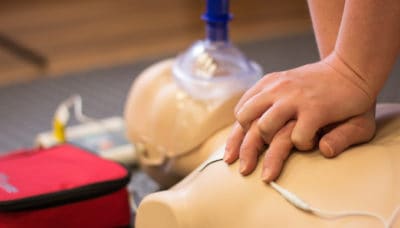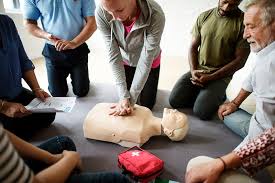Introduction
In a globe where mishaps can happen at any moment, knowing exactly how to react efficiently can be the distinction between life and fatality. Cardiopulmonary resuscitation (CPR) is a crucial skill that everybody ought to take into consideration discovering. Yet with a lot of alternatives available, navigating the world of mouth-to-mouth resuscitation courses can really feel frustrating. So, which one is right for you? This post aims to direct you through the various mouth-to-mouth resuscitation training courses available, helping you choose the best suitable for your needs.
Understanding CPR and Its Importance
What is CPR?
Cardiopulmonary resuscitation (MOUTH-TO-MOUTH RESUSCITATION) is an emergency situation procedure performed on people whose heart has actually stopped beating or who have ceased breathing. It entails breast compressions and rescue breaths to preserve blood circulation and oxygenation till innovative clinical assistance shows up.

Why is CPR Important?
The significance of mouth-to-mouth resuscitation can not be overstated. Statistics reveal that immediate CPR can double and even triple a victim's possibilities of survival after heart attack. Learning CPR not just equips you with the skills to conserve lives yet likewise enhances your self-confidence in emergency situation situations.
When Ought to You Use CPR?
The original sourceCPR should be started when a person is unresponsive, not taking a breath usually, or exhibiting indications of severe distress. Being able to determine these situations swiftly can conserve valuable minutes.
Navigating the Globe of Mouth-to-mouth Resuscitation Courses: Kinds Available
Basic Life Assistance (BLS) Courses
What is BLS?
BLS training courses are developed for healthcare providers and specialists who require to maintain qualification in fundamental life assistance methods. These training courses cover crucial skills such as high-grade upper body compressions, air passage administration, and utilizing an Automated External Defibrillator (AED).

Who Ought to Take BLS Courses?
If you're a healthcare worker, caretaker, or someone seeking to boost their clinical knowledge, a BLS course may be proper for you.

Heartsaver ® CPR/AED Courses
What are Heartsaver ® Courses?
The Heartsaver ® program supplies training courses tailored for nonprofessionals. It focuses on grownup, youngster, and baby CPR techniques in addition to AED usage.
Who Should Think about Heartsaver ® Courses?
These programs are excellent for educators, instructors, moms and dads, and anyone responsible for others' safety and security who may require to act in an emergency situation.
First Help Training course vs. First Aid and CPR Course
What Does an Emergency treatment Course Cover?
A first aid course typically covers the fundamentals of dealing with injuries such as cuts, burns, cracks, and choking events without concentrating on resuscitation methods.
Why Combine First Aid with Mouth-to-mouth Resuscitation Training?
Combining first aid training with a mouth-to-mouth resuscitation program equips you with extensive emergency situation reaction abilities. By comprehending both emergency treatment and resuscitation strategies, you'll be better prepared to deal with numerous emergencies.
Advanced Heart Life Assistance (ACLS)
What is ACLS Training?
ACLS training exceeds fundamental life assistance by consisting of sophisticated medical abilities like carrying out medications and handling respiratory system failure.
Who Needs ACLS Certification?
ACLS qualification is typically needed for health care professionals working in important treatment setups such as hospitals or emergency rooms.
Choosing the Right Course for You: Aspects to Consider
Your Degree of Experience
Before joining in any training course, examine your present level of knowledge relating to first aid and mouth-to-mouth resuscitation methods. Newbies may gain from starter programs like Heartsaver ®, while knowledgeable individuals may choose even more intensive training like BLS or ACLS.
Your Responsibilities
Consider your duty in your area or workplace. If you are in charge of others' safety-- like a train or educator-- you could want to invest time in thorough emergency treatment and CPR training.
Course Layout: In-Person vs. Online Options
In-Person Training Advantages
- Hands-on experience Immediate comments from instructors Networking opportunities
Online Training Advantages
- Flexibility Convenience Often less expensive
Understanding Accreditation: What You Need to Know
Duration of Certifications
Most accreditations last between two to three years before requiring renewal; nevertheless, this differs by organization.
Recognized Organizations Offering Certification
Several companies supply trusted qualification programs:
- American Heart Organization (AHA) Red Cross National Security Council (NSC)
Finding Quality Educating Providers
Researching Regional Options
Look right into neighborhood medical facilities or community centers using emergency treatment courses to discover practical options near you.
Online Resources
Many companies offer on-line training components that give qualification upon conclusion-- an exceptional choice if time restrictions are an issue.
Costs Related to Numerous Courses
|Training course Type|Average Price|| ---------------------|----------------|| Standard Life Assistance|$100 - $150|| Heartsaver ®|$50 - $80|| First Aid Just|$60 - $100|| ACLS|$200 - $300|
How to Get ready for Your Course
Pre-Course Recommendations
Before attending course:
Review any type of offered materials. Wear comfortable clothing. Bring any needed products noted by your instructor.What Takes place After Completion?
After effectively finishing your selected training course:
You'll get an accreditation card. Keep it upgraded according to your service provider's guidelines. Apply what you've learned on a regular basis with session if possible!Common False impressions Regarding First Aid and CPR Training
Misconception 1: Only Healthcare Professionals Required This Training
This could not be better from the fact! Everyone can take advantage of knowing just how to provide first aid or do CPR!
Misconception 2: I'll Never Need to Utilize It
Emergency circumstances arise unexpectedly; being prepared is constantly wise!
FAQs Regarding First Aid Certificates & Courses
How long does it take to complete a normal first aid course? The majority of first aid courses take about 4 hours but can differ depending on content depth.
Will I receive a certificate after finishing my course? Yes! The majority of reputable organizations provide certifications upon effective completion.
How often do I require to renew my certification? Usually every 2 years; contact your certifying organization.
Can I take these courses online? Absolutely! Lots of companies offer online alternatives enabling flexibility.
Are there age requirements for taking these courses? Typically no age limitation exists; nonetheless, parental approval might be needed under certain circumstances.
Do employers call for workers to have these certifications? Lots of employers do favor employee trained in initial aid/CPR-- it reveals commitment towards workplace safety!
Conclusion: Your Trip Starts Now!
With so many options offered when it comes down choosing which program fits best-- whether it's Standard Life Assistance (BLS), Heartsaver ®, Advanced Heart Life Assistance (ACLS), or even simply basic Emergency treatment-- the essential takeaway stays clear: Taking proactive steps towards enhancing your data base around first aid & & cardiopulmonary resuscitation will inevitably empower YOU! By spending time right into browsing the world of CPR programs responsibly today makes certain preparedness tomorrow-- because every 2nd counts during emergencies!